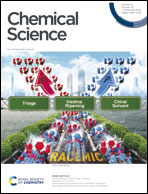Spontaneous and induced chiral symmetry breaking of stereolabile pillar[5]arene derivatives upon crystallisation†
Abstract
Stereolabile pillar[5]arene (P[5]) derivatives, which are dynamic racemic mixtures in solution on account of their low inversion barriers, were employed as platforms to study chiral symmetry breaking during crystallisation. In the solid state, we showed that crystal enantiomeric excess of a conglomerate-forming P[5] derivative can be obtained by handpicking and Viedma ripening without the intervention of external chiral entities. On the other hand, in the presence of ethyl D/L-lactate as both optically-active solvents and chiral guests, the handedness of P[5] derivative crystals, either forming racemic compounds or conglomerates upon condensation, can be directed and subsequently inverted in a highly controllable manner.
![Graphical abstract: Spontaneous and induced chiral symmetry breaking of stereolabile pillar[5]arene derivatives upon crystallisation](/en/Image/Get?imageInfo.ImageType=GA&imageInfo.ImageIdentifier.ManuscriptID=D1SC02560K&imageInfo.ImageIdentifier.Year=2021)
- This article is part of the themed collections: Most popular 2021 supramolecular chemistry articles, 2021, 2021 Chemical Science HOT Article Collection and In celebration of Chinese New Year, 2022


 Please wait while we load your content...
Please wait while we load your content...